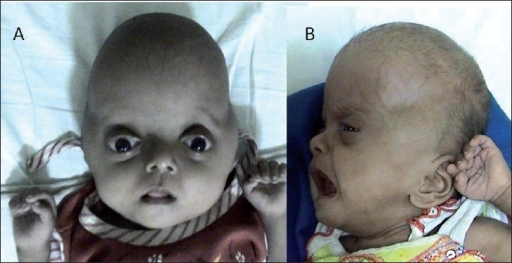Pfeiffer Syndrome Type 2

Pfeiffer syndrome type 2 (PS2) is a frequent and severe type of Pfeiffer syndrome (PS; see this term), characterized by cloverleaf skull, severe associated functional disorders, and hand/foot and elbow/knee abnormalities.
Epidemiology
The exact annual incidence of this form of PS is not known but the incidence of all forms of PS is 1/100,000.
Clinical description
Patients with PS2 present with cloverleaf skull (trilobated skull deformity) that can cause limited brain growth and associated neurological dysfunction as well as significant upper respiratory compromise. The second main characteristic is broad medially deviated thumbs and halluces and variable brachydactyly and syndactyly, as well as ankylosis of the elbow or knee. Neurological manifestations such as hydrocephalus and seizures are a major source of morbidity. Developmental and intellectual delays are common. Extreme proptosis associated with the cloverleaf deformity causes exposure keratopathy. Additional ocular signs include optic atrophy, ptosis, strabismus, iris coloboma, refractive errors, cataracts and amblyopia. Respiratory tract abnormalities such as cleft palate, choanal stenosis or atresia and laryngotracheal malformations may also be present. Resultant airway obstruction and obstructive sleep apnea are a significant source of morbidity. Patients with cerebral or cerebellar hernia, intestinal malrotation, malposition of the anus, hydronephrosis, bifid scrotum, and hypoplastic gall bladder have also been reported. Given the severity of the disease manifestations and associated complications, the prognosis of this type of PS is poor, with a high risk of early demise, although the potential for long-term survival may be increased by aggressive early treatment. Causes of death are mainly respiratory and neurological complications.
Etiology
Mutations in the FGFR2 gene (10q25.3-q26) involved in embryonic developmental cell signaling have been found to be causative in PS2. FGFR2 mutations are most commonly detected (69% in one study) followed by FGFR1 (8%).
Genetic counseling
Pfeiffer syndrome follows an autosomal dominant pattern of inheritance but is generally caused by de novo mutations, especially in the severe forms of the syndrome. Genetic counseling should be provided to affected families.